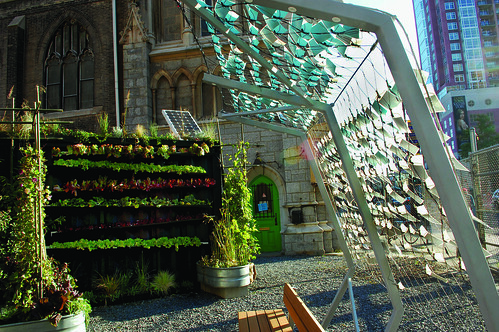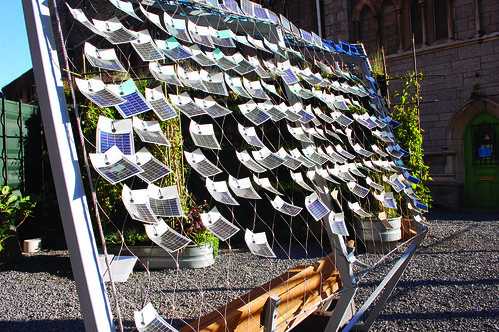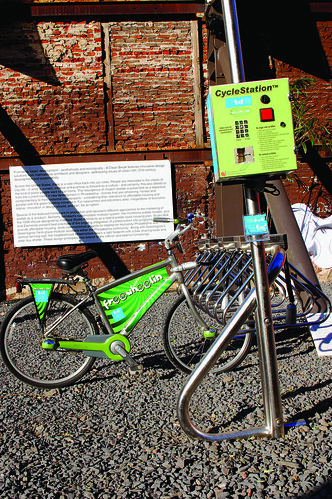With the economy in a recession, a burgeoning energy crisis, and 80-degree temperatures extending into November, the onus for adopting sustainable alternatives now falls on everyone.
But what is there to do besides recycling? And isn’t “green” and “sustainable” usually code for expensive and ugly?
Not anymore.
Minima, a contemporary furniture showroom, is hosting “A Clean Break,” an exhibit featuring sustainable urban homes that are affordable and aesthetically pleasing.

Designers Elizabeth Oliver and Eugenie Perret have a simple philosophy about art that’s based on the balance between form and function. And as its name implies, the furniture collection at Minima embodies minimalist designs, yet still evokes sensuality and warmth, rather than rigid and museum-like resonances.
It was one of the many exhibits that participated in DesignPhiladelphia, a two-week festival showcasing art and architecture throughout the city.
“DesignPhiladelphia has mostly been an insular event,” Oliver said. “So we wanted to broaden the goals of DesignPhiladelphia, now in its fourth year.”
But more inspired “A Clean Break” than the incentive to broaden horizons.

When Perret lived in Northern Liberties, she observed disparate housing developments springing up piecemeal. She discovered developers did not receive approval from the community on the style or make-up of their projects.
“It had become a huge free-for-all…with pseudo-historical units that have been ruining the integrity of the city,” Perret said.
In this case, diversity is not the spice of life but the scourge of the housing market. Gentrification left Northern Liberties looking like a neighborhood from a Hollywood movie set. Prices for homes skyrocketed, reaching nearly $750,000.
Luckily, “A Clean Break” aims to rectify both the housing and energy crisis.
All the units showcased at “A Clean Break” utilize prefabricated materials, which have more advantages than the typical stick and brick-built dwelling.
“Of course, prefab can mean a number of things. But in terms of the homes shown at the exhibit, practically everything is built at the factory, which saves on waste, transportation and contracting work,” Oliver said.

“These are designs that are affordable. [‘A Clean Break’] is all about mixing good design and affordability,” Perret added.
Of the several models exhibited, one stood apart from the rest: the miniHome, which is not only an ecological trailer home but also a paradigm of sustainable living.
Altius Architecture Inc. of Toronto will release the miniHome 12WIDE in 2009. These miniHomes will have the most spacious and flexible floor plans to support all kinds of future additions.
So what exactly makes miniHome sustainable?
The solar panel fixtures on the homes’ awnings can store up to three days worth of off-grid energy. Wind turbine and gray water purification attachments can be easily installed, and each home is fully equipped with LED lighting. Also, all hard surfaces are made of Sustainable Furniture Council-certified woods, and the carpets are made of recycled wood fibers.
Andy Thomson, an associate designer at Altius Architecture Inc., designed the miniHome to withstand harsh Canadian winters. The miniHomes discredit notions that prefab and sustainable green homes are viable only in predominantly warmer climates.
The miniHome is a testament to the possibilities of sustainable living. Habitat for Humanity, which is also exhibiting home designs at “A Clean Break,” has already built a prefab home in Kensington and plans to erect another at 19th and Norris streets in the near future. These homes will cost between $100,000 and $150,000.
“Since Mayor Michael Nutter created the Office of Sustainability, Oliver and Perret have advocated for greener alternatives. With the help from City Hall, Oliver and Perret hope to start a Philly bike share program and encourage the rewriting of city-zoning ordinances to accommodate sustainable units.
Sustainable living does not begin and end with purchasing a greener home; it requires revolutionizing one’s way of life.
“Architecture has a certain permanence about it, and with more and more young architects thinking more progressively about sustainability, it’s looking like any type of aesthetic constituted by sustainable elements or qualities is going to stick around,” Oliver said. “And that’s a good sign.”
Aaron Stella can be reached at aaron.stella@temple.edu.


Be the first to comment